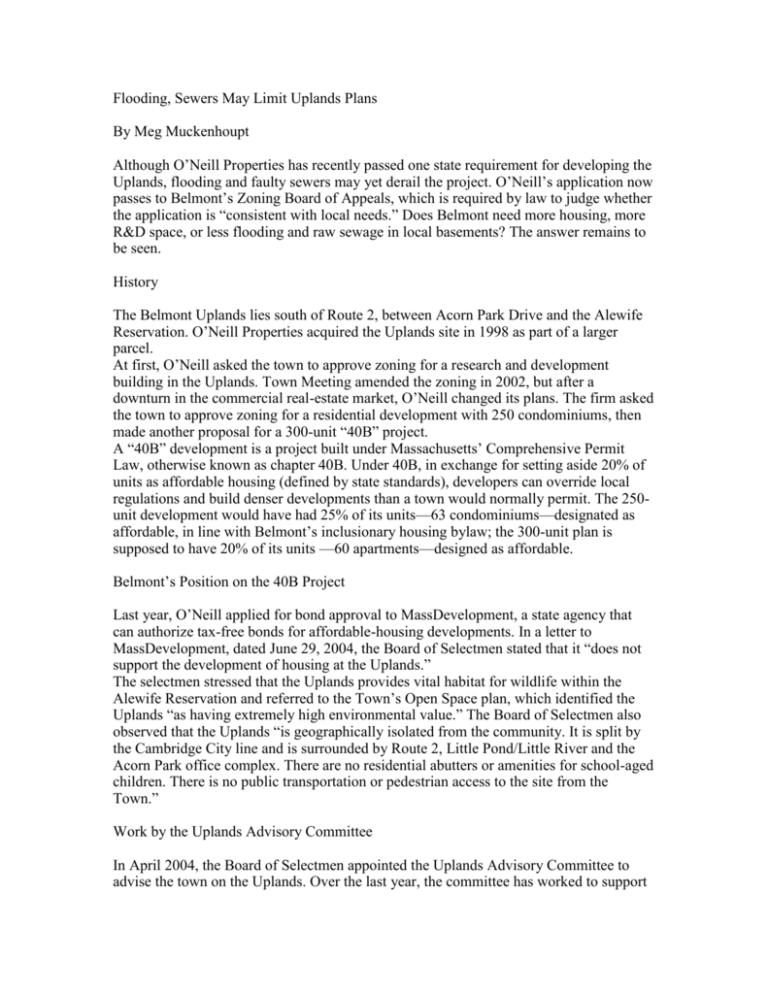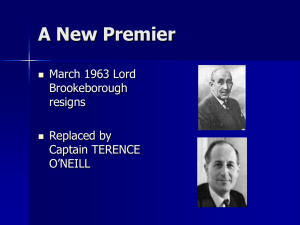Flooding, Sewers May Limit Uplands Plans By Meg Muckenhoupt
advertisement

Flooding, Sewers May Limit Uplands Plans By Meg Muckenhoupt Although O’Neill Properties has recently passed one state requirement for developing the Uplands, flooding and faulty sewers may yet derail the project. O’Neill’s application now passes to Belmont’s Zoning Board of Appeals, which is required by law to judge whether the application is “consistent with local needs.” Does Belmont need more housing, more R&D space, or less flooding and raw sewage in local basements? The answer remains to be seen. History The Belmont Uplands lies south of Route 2, between Acorn Park Drive and the Alewife Reservation. O’Neill Properties acquired the Uplands site in 1998 as part of a larger parcel. At first, O’Neill asked the town to approve zoning for a research and development building in the Uplands. Town Meeting amended the zoning in 2002, but after a downturn in the commercial real-estate market, O’Neill changed its plans. The firm asked the town to approve zoning for a residential development with 250 condominiums, then made another proposal for a 300-unit “40B” project. A “40B” development is a project built under Massachusetts’ Comprehensive Permit Law, otherwise known as chapter 40B. Under 40B, in exchange for setting aside 20% of units as affordable housing (defined by state standards), developers can override local regulations and build denser developments than a town would normally permit. The 250unit development would have had 25% of its units—63 condominiums—designated as affordable, in line with Belmont’s inclusionary housing bylaw; the 300-unit plan is supposed to have 20% of its units —60 apartments—designed as affordable. Belmont’s Position on the 40B Project Last year, O’Neill applied for bond approval to MassDevelopment, a state agency that can authorize tax-free bonds for affordable-housing developments. In a letter to MassDevelopment, dated June 29, 2004, the Board of Selectmen stated that it “does not support the development of housing at the Uplands.” The selectmen stressed that the Uplands provides vital habitat for wildlife within the Alewife Reservation and referred to the Town’s Open Space plan, which identified the Uplands “as having extremely high environmental value.” The Board of Selectmen also observed that the Uplands “is geographically isolated from the community. It is split by the Cambridge City line and is surrounded by Route 2, Little Pond/Little River and the Acorn Park office complex. There are no residential abutters or amenities for school-aged children. There is no public transportation or pedestrian access to the site from the Town.” Work by the Uplands Advisory Committee In April 2004, the Board of Selectmen appointed the Uplands Advisory Committee to advise the town on the Uplands. Over the last year, the committee has worked to support a proposal for a “land swap.” The idea is that O’Neill would donate the Uplands to the Alewife Reservation (owned by the state Department of Conservation and Recreation [DCR]), and in exchange the DCR would give O’Neill a nearby abandoned skating-rink site. The rink site could hold 150 housing units. New Flood Information The Uplands plays a vital role in regional water management, reducing both flooding and water shortages by slowly releasing groundwater. The vegetation on the property also acts to reduce flooding through evaporation, via the forest’s natural transpiration from leaves and other vegetation. The Federal Emergency Management Agency (FEMA) is currently in the process of reevaluating the 1982 floodplain maps. (See “What is a Floodplain Map?” on page 11.) Preliminary results show an increase of 29 inches in the height of the 100-year-floodplain (the area that would be covered by a flood that has a 1% chance of occurring in any given year), from 8.2 feet above sea level to 10.6 feet. This increase means that a larger part of the buildable area of the Uplands will fall within the floodplain and so be subject to: lThe state Building Code, which specifies that the lowest floor of any building must be above the 100-year flood elevation. l The Wetlands Protection Act, which states that when flood storage is removed (i.e., when wetlands, which store and slowly release water during floods, are disrupted), new flood storage needs to be added near the original area and at the same elevation from which flood storage is being removed. The Wetlands Protection Act also requires an inventory of significant wildlife-habitat areas; habitats identified must be taken into account in planning. The new flood elevation would affect portions of both the 242,000-square-foot R&D/office complex for which O’Neill has zoning permission and the 300-unit 40B Project for which O’Neill is seeking approval. It would also affect the proposed land swap. Since the entire rink site is within the new 100-year floodplain, construction on that property would require the creation of even larger flood detention facilities. The new FEMA floodplain study is not yet final. However, the state’s Wetlands Protection Act does allow the Belmont Conservation Commission to use new flood data developed by a professional engineer demonstrating that the 1982 FEMA flood delineation is no longer accurate. The Conservation Commission takes the position that O’Neill must consider the new flood data in its application for the R&D project. Other Environmental Issues The 300-unit 40B Project will discharge a high volume of sanitary waste to a town sewer system that is already in need of repair. That system connects to a combined sewer overflow system that disharges untreated wastewater and sewerage directly into Alewife Brook during heavy rains. The combination of increased flooding levels, increased sewerage discharge from such a large scale development and a town sewer system already discharging into Belmont’s basements and waterways should be a focus and concern for Belmont’s ZoningBoard of Appeals. An Alternative for all Three Communities With the support of Belmont, Arlington, and Cambridge, the DCR could buy the Uplands from O’Neill, using several funding sources. For example, by adopting the Community Preservation Act and obtaining matching dollars from the state, Belmont could raise both open-space money and money to support affordable housing throughout the town. All of O’Neill’s building plans would destroy valuable natural area and wildlife habitat. In addition, O’Neill has not presented a single study to demonstrate that the 40B project will match in tax receipts what it will cost in town services. An R&D project might not actually cost the town money—but many residents questions whether the minimal increase in tax receipts is worth what will be irrevocably destroyed. The Current Status In February, MassDevelopment ruled that O’Neill’s 40B project was eligible for financing with tax-exempt bonds. That does not mean that MassDevelopment has committed to funding the project, only that MassDevelopment believes that O’Neill’s application fulfills the 40B requirements. Next, Belmont’s Zoning Board of Appeals (ZBA) will review O’Neill’s application for a Comprehensive (40B) Permit. Under 40B, the ZBA must balance “local needs” against the need for affordable housing. Such a review should examine flooding, wetland impacts, sanitary waste overflow, infrastructure capacity, and the new 100-year floodplain, as well as questions concerning public safety, density, pedestrian safety, and impact on schools. Belmont can expect the ZBA to thoroughly review all these issues.








